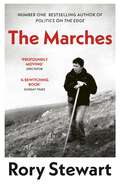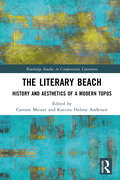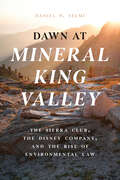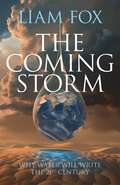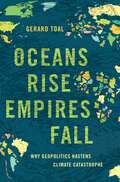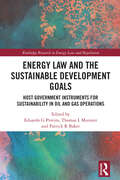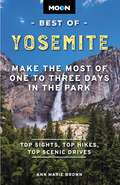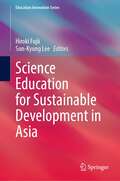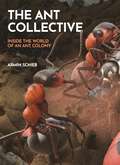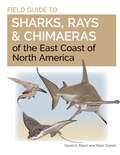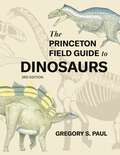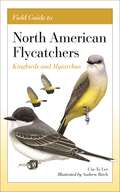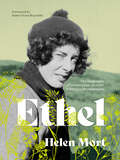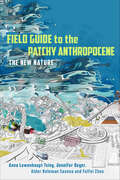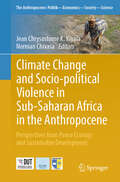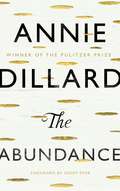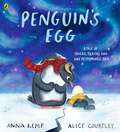- Table View
- List View
Twelve Words for Moss: Love, Loss And Moss
by Elizabeth-Jane BurnettSHORTLISTED FOR THE JHALAK PRIZE 2024Shortlisted for the Wainwright Prize 2023 for Nature Writing'Exquisite, luminous and quietly radical . . . utterly unique and refreshing' Lucy JonesWhere nothing grows, moss is the spark that triggers new life. Embarking on a journey though landscape, memory and recovery, Elizabeth-Jane Burnett explores this mysterious, ancient marvel of the plant world, meditating on and renaming her favourite mosses – from Glowflake to Little Loss – and drawing inspiration from place, people and language itself. 'Fascinating, subtle and risk-taking . . . Poetry, descriptive-evocative prose, memory, memoir, natural history and more all drift and mingle in strikingly new ways' Robert Macfarlane
The Marches: A Borderland Journey Between England And Scotland
by Rory StewartTHE NO. 1 BEST-SELLING AUTHOR OF POLITICS ON THE EDGERory Stewart explores his love for the UK in this account of history, memory and landscape as he traverses the the borderlands between England and Scotland.‘This beautifully written book is a haunting reflection of identity and our relationships with the people and places we love’ Daily MailHis father Brian taught Rory Stewart how to walk, and walked with him on journeys from Iran to Malaysia. Now they have chosen to do their final walk together along ‘the Marches’ - the frontier that divides their two countries, Scotland and England.On their six-hundred-mile, thirty-day journey - with Rory on foot, and his father ‘ambushing’ him by car – the pair relive Scottish dances, reflect on Burmese honey-bears, and on the loss of human presence in the British landscape.Travelling across mountain ridges and through housing estates they uncover a forgotten country crushed between England and Scotland: the Middleland. They discover unsettling modern lives, lodged in an ancient place, as their odyssey develops into a history of the British nationhood, a chronicle of contemporary Britain and an exuberant encounter between a father and a son.And as the journey deepens, and the end approaches, Brian and Rory fight to match, step by step, modern voices, nationalisms and contemporary settlements to the natural beauty of the Marches, and a fierce absorption in tradition in their own unconventional lives.‘Suggests an open-mindedness in Stewart, a tolerance and flexibility that could make him an exceptional politician while it also continues to define him as a writer’ New York Review of Books‘Travel writing at its best’ GuardianPlease note: The book cover received may differ from the cover displayed here.
The Literary Beach: History and Aesthetics of a Modern Topos (Routledge Studies in Comparative Literature)
by Carsten Meiner Katrine Helene AndersenAs a geo-historical place, the beach integrates a variety of characteristics and functions so multiple that they tend to contradict each other. The beach is both a place of work and trade but also of leisure; it is both a place of therapy and health but also of migration, war, and death; it is a place of mass tourism and boredom but also the place of experiencing the Other; it is a public place but also an uncivilized and desolate place.This book studies the literary representation of the beach from ancient Greek literature up until today, drawing on English, French, Italian, American, and Spanish literatures from various periods and genres and presenting multiple ways of comparing and understanding literary beaches as a ubiquitous literary phenomenon. It demonstrates how the literary beach as a both geo-historical place and as an aesthetic literary commonplace has been a constant and privileged resource for the analysis of more general existential, sociological, and moral problems. This is the case when for instance the Tahitian beach becomes the place of the "already modern" in Stevenson's tales, or when the Italian beach becomes a question of modern feminism in Ferrante.In this sense, literature expands the local or national beach by articulating its transnational complexities.
The Literary Beach: History and Aesthetics of a Modern Topos (Routledge Studies in Comparative Literature)
As a geo-historical place, the beach integrates a variety of characteristics and functions so multiple that they tend to contradict each other. The beach is both a place of work and trade but also of leisure; it is both a place of therapy and health but also of migration, war, and death; it is a place of mass tourism and boredom but also the place of experiencing the Other; it is a public place but also an uncivilized and desolate place.This book studies the literary representation of the beach from ancient Greek literature up until today, drawing on English, French, Italian, American, and Spanish literatures from various periods and genres and presenting multiple ways of comparing and understanding literary beaches as a ubiquitous literary phenomenon. It demonstrates how the literary beach as a both geo-historical place and as an aesthetic literary commonplace has been a constant and privileged resource for the analysis of more general existential, sociological, and moral problems. This is the case when for instance the Tahitian beach becomes the place of the "already modern" in Stevenson's tales, or when the Italian beach becomes a question of modern feminism in Ferrante.In this sense, literature expands the local or national beach by articulating its transnational complexities.
Dawn at Mineral King Valley: The Sierra Club, the Disney Company, and the Rise of Environmental Law
by Daniel P. SelmiThe story behind the historic Mineral King Valley case, which reveals how the Sierra Club battled Disney’s ski resort development and launched a new environmental era in America. In our current age of climate change–induced panic, it’s hard to imagine a time when private groups were not actively enforcing environmental protection laws in the courts. It wasn’t until 1972, however, that a David and Goliath–esque Supreme Court showdown involving the Sierra Club and Disney set a revolutionary legal precedent for the era of environmental activism we live in today. Set against the backdrop of the environmental movement that swept the country in the late 1960s and early 1970s, Dawn at Mineral King Valley tells the surprising story of how the US Forest Service, the Disney company, and the Sierra Club each struggled to adapt to the new, rapidly changing political landscape of environmental consciousness in postwar America. Proposed in 1965 and approved by the federal government in 1969, Disney’s vast development plan would have irreversibly altered the practically untouched Mineral King Valley, a magnificently beautiful alpine area in the Sierra Nevada mountains. At first, the plan met with unanimous approval from elected officials, government administrators, and the press—it seemed inevitable that this expanse of wild natural land would be radically changed and turned over to a private corporation. Then the scrappy Sierra Club forcefully pushed back with a lawsuit that ultimately propelled the modern environmental era by allowing interest groups to bring litigation against environmentally destructive projects. An expert on environmental law and appellate advocacy, Daniel P. Selmi uses his authoritative narrative voice to recount the complete history of this revolutionary legal battle and the ramifications that continue today, almost 50 years later.
The Coming Storm: Why water will write the 21st Century
by Liam FoxFollowing Russia's aggressive war in Ukraine, the world is suddenly gripped by concerns over energy security. And yet, there is an even greater threat ahead – one that is much more likely to shape the events of the twenty-first century than the competition for oil or gas. The combination of an ever-increasing global population, climate change, industrialisation, urbanisation and limited natural resources means that one difficulty, above all, will shape the political, economic and security environment in the years ahead: that is water. If people and nations will fight for fossil fuels, it is nothing compared to what they will do for the most vital natural resource of all. As both a citizen who has supported water charities and worked in the NHS and a politician who has dealt with security and economic issues, Liam Fox tells the story of water and the problems it presents in a more complete way than ever before. The Coming Storm unites a range of concerns that are often written about separately but seldom together and provides a comprehensible and compelling call for urgent action.
Oceans Rise Empires Fall: Why Geopolitics Hastens Climate Catastrophe
by Gerard ToalA powerful explanation of why geopolitical competition makes implementing effective climate change policies so difficult. As the Russia-Ukraine war has shown, great-power competition drives states to prioritize fossil fuel acquisition over working toward a zero-carbon future. In the last few years, it has become abundantly clear that the effects of accelerating climate change will be catastrophic, from rising seas to more violent storms to desertification. Yet why do nation-states find it so difficult to implement transnational policies that can reduce carbon output and slow global warming? In Oceans Rise, Empires Fall, Gerard Toal identifies geopolitics as the culprit. States would prefer to reduce emissions in the abstract, but in the great global competition for geopolitical power, states always prioritize access to carbon-based fuels necessary for generating the sort of economic growth that helps them compete with rival states. Despite what we now know about the long-term impacts of climate change, geopolitical contests continue to sideline attempts to halt or slow down the process. The Ukraine conflict in particular exposes our priorities. To escape reliance on Russia's vast oil and gas reserves, states have expanded fossil fuel production that necessarily increases the amount of carbon in the atmosphere. The territorial control imperatives of great powers preclude collaborative behavior to address common challenges. Competitive territorial, resource, and technological dramas across the geopolitical chessboard currently obscure the deterioration of the planet's life support systems. In the contest between geopolitics and sustainable climate policies, the former takes precedence-especially when competition shifts to outright conflict. In this book, Toal interrogates that relationship and its stakes for the ongoing acceleration of climate change.
Fueling State Capitalism: How Domestic Politics Shapes Foreign Investments of National Oil Companies (STUDIES COMPAR ENERGY ENVIRON POL SERIES)
by Andrew CheonIn the late 1990s, governments began investing hundreds of billions of dollars in foreign oil and gas assets through their national oil companies (NOCs), raising concerns about a "resource war" and asymmetric interdependence. Most critics perceive the foreign investments of NOCs as politically driven and inefficient. In Fueling State Capitalism, however, Andrew Cheon sees these investments as commercial ventures by ambitious state-owned enterprises seeking to become global players amid rising oil prices. Some have invested aggressively abroad, often in politically risky destinations, whereas others have been more moderate in their ambitions. The NOCs' capacity to pursue foreign investments varies, as Cheon argues, according to regime types and bureaucratic structures of their governments. Using principal agent theory, Cheon shows that competition among NOCs' principals at two different levels of government--national and bureaucratic--conditions the foreign investments of NOCs. While competition between the chief executive and opposition parties can limit democratic governments' capacity to tolerate failed investments abroad, non-democratic governments are less constrained. An overlap of authority among bureaucratic institutions can also encourage counterproductive behavior among NOCs, whereas a clear line of authority among them can prevent it. Looking at investments from 79 countries from 2000 to 2013, as well as case studies of China, India, Brazil, Norway, and Russia, Fueling State Capitalism unpacks the role of institutions, both national and bureaucratic, in shaping the global expansion of national energy firms. Moreover, Cheon probes the energy security motivations of NOC investments and the origins of bureaucratic structures. Based on the experience of NOC global expansion, Cheon concludes that bureaucratic institutions will be critical in achieving decarbonization that not only allows governments to meet their political objectives, but also helps NOCs ensure their long-term commercial viability through a managed transition to renewable energy.
Oceans Rise Empires Fall: Why Geopolitics Hastens Climate Catastrophe
by Gerard ToalA powerful explanation of why geopolitical competition makes implementing effective climate change policies so difficult. As the Russia-Ukraine war has shown, great-power competition drives states to prioritize fossil fuel acquisition over working toward a zero-carbon future. In the last few years, it has become abundantly clear that the effects of accelerating climate change will be catastrophic, from rising seas to more violent storms to desertification. Yet why do nation-states find it so difficult to implement transnational policies that can reduce carbon output and slow global warming? In Oceans Rise, Empires Fall, Gerard Toal identifies geopolitics as the culprit. States would prefer to reduce emissions in the abstract, but in the great global competition for geopolitical power, states always prioritize access to carbon-based fuels necessary for generating the sort of economic growth that helps them compete with rival states. Despite what we now know about the long-term impacts of climate change, geopolitical contests continue to sideline attempts to halt or slow down the process. The Ukraine conflict in particular exposes our priorities. To escape reliance on Russia's vast oil and gas reserves, states have expanded fossil fuel production that necessarily increases the amount of carbon in the atmosphere. The territorial control imperatives of great powers preclude collaborative behavior to address common challenges. Competitive territorial, resource, and technological dramas across the geopolitical chessboard currently obscure the deterioration of the planet's life support systems. In the contest between geopolitics and sustainable climate policies, the former takes precedence-especially when competition shifts to outright conflict. In this book, Toal interrogates that relationship and its stakes for the ongoing acceleration of climate change.
Energy Law and the Sustainable Development Goals: Host Government Instruments for Sustainability in Oil and Gas Operations (Routledge Research in Energy Law and Regulation)
by Eduardo G Pereira Thomas L Muinzer Patrick R BakerThe UN Sustainable Development Goals are an ambitious agenda for environmental sustainability, economic development, and social transformation. The SDGs include targets for governments, in partnership with private industry and communities, to improve access to affordable and reliable energy, reduce inequality, protect natural resources, and invest in transparent legal institutions and resilient infrastructure. Although transitioning energy systems towards a low-carbon future is a core aspect of the SDGs, the International Energy Agency anticipates that oil and gas will remain a significant component of the global energy mix for some time. Host Government Instruments are tools which governments use to grant oil and gas companies permission to develop state-owned resources. In addition to bringing substantial resources into governments, these HGIs often also include environmental commitments as well as commitments to local hiring, stakeholder engagement, and investment in economic development programmes. The different structures of HGIs and their precise terms and conditions are crucial determinants of the sustainability of oil and gas operations conducted thereunder. This book addresses how governments can use HGIs to advance the SDGs. Part I introduces the SDGs and the legal institutions and governance related to HGIs, including in relation to international energy development, international environmental treaties, the Paris Agreement, and human rights regimes. Part II examines specific provisions within HGIs and regulatory systems which relate to the oil and gas sector and SDGs. It provides case studies to illustrate approaches to HGIs and to identify opportunities for host governments and international oil and gas companies to advance the SDGs. The book concludes with a summary of recommendations regarding how host governments, in partnership with the oil and gas industry, can use HGIs to advance economic development and sustainability goals, and advances potential insights towards development of new and renewable resources.
Energy Law and the Sustainable Development Goals: Host Government Instruments for Sustainability in Oil and Gas Operations (Routledge Research in Energy Law and Regulation)
The UN Sustainable Development Goals are an ambitious agenda for environmental sustainability, economic development, and social transformation. The SDGs include targets for governments, in partnership with private industry and communities, to improve access to affordable and reliable energy, reduce inequality, protect natural resources, and invest in transparent legal institutions and resilient infrastructure. Although transitioning energy systems towards a low-carbon future is a core aspect of the SDGs, the International Energy Agency anticipates that oil and gas will remain a significant component of the global energy mix for some time. Host Government Instruments are tools which governments use to grant oil and gas companies permission to develop state-owned resources. In addition to bringing substantial resources into governments, these HGIs often also include environmental commitments as well as commitments to local hiring, stakeholder engagement, and investment in economic development programmes. The different structures of HGIs and their precise terms and conditions are crucial determinants of the sustainability of oil and gas operations conducted thereunder. This book addresses how governments can use HGIs to advance the SDGs. Part I introduces the SDGs and the legal institutions and governance related to HGIs, including in relation to international energy development, international environmental treaties, the Paris Agreement, and human rights regimes. Part II examines specific provisions within HGIs and regulatory systems which relate to the oil and gas sector and SDGs. It provides case studies to illustrate approaches to HGIs and to identify opportunities for host governments and international oil and gas companies to advance the SDGs. The book concludes with a summary of recommendations regarding how host governments, in partnership with the oil and gas industry, can use HGIs to advance economic development and sustainability goals, and advances potential insights towards development of new and renewable resources.
Moon Best of Yosemite: Make the Most of One to Three Days in the Park (Moon Best of Travel Guide)
by Ann Marie Brown Moon Travel GuidesWhether you're visiting the park for a day hike or spending a long weekend under the stars, escape to the great outdoors with Moon Best of Yosemite. Inside you'll find:Easy itineraries for one to three days in Yosemite National Park, from a morning drive along the Tioga Pass Road, to a day hike along the Panorama Trail, to a full weekend exploring the park The top hikes in Yosemite: Whether you're looking to stretch your legs for a couple hours or challenge yourself to an epic trek, you'll find trailheads, detailed trail descriptions, individual maps, mileage, and elevation gains Can't-miss experiences: Make it the perfect getaway for you with the best waterfalls, views, picnic spots, and more. Ride the open-air tram through Yosemite Valley or hike downhill from Glacier Point past roaring waterfalls. Admire the towering trees in the Mariposa Grove of Giant Sequoias, or spot black bears and bighorn sheep Stunning full-color photos and detailed maps throughout, plus a full-color foldout mapEssential planning tips: Find out when to go, where to stay, and what to pack, plus up-to-date information on entrance fees, reservations, and safety advice Know-how from outdoorswoman and Yosemite expert Ann Marie BrownMake the most of your adventure with Moon Best of Yosemite. Spending more time in the park or expanding your trip? Try Moon Yosemite, Sequoia & Kings Canyon. Visiting more of North America's incredible national parks? Try Moon USA National Parks.About Moon Travel Guides: Moon was founded in 1973 to empower independent, active, and conscious travel. We prioritize local businesses, outdoor recreation, and traveling strategically and sustainably. Moon Travel Guides are written by local, expert authors with great stories to tell—and they can't wait to share their favorite places with you. For more inspiration, follow @moonguides on social media.
Science Education for Sustainable Development in Asia (Education Innovation Series)
by Hiroki Fujii Sun-Kyung LeeThis book presents an Asian perspective on transformative science education in the context of the United Nations' Sustainable Development Goals (SDGs). The chapters are written by contributors who practiced science education for sustainability in a research project entitled “Teacher Education for ESD in the Asia-Pacific Region” from 2017 to 2019, supported by the Japan Society for the Promotion of Science, and the Japanese National Commission for UNESCO. The book showcases the contributors’ innovations in science education for sustainability, presenting case studies of science teaching and learning, science curriculum and assessment, science education in collaboration with local communities, and science teacher education. Embodying Asian sustainability education paradigms, policies, and practices, these case studies depict the diversity and uniqueness of natural, social, and cultural contexts in Asia, while demonstrating their commonalities. Through examining these case studies, this book aims to provide examples for praxis, and prospects, for new science classes, curricula, and teacher education in implementing education for sustainable development.
The Ant Collective: Inside the World of an Ant Colony
by Armin SchiebAnts come alive on this fabulously illustrated journey into the heart of a bustling colonyAnts share a vibrant and complex communal life and remarkable abilities to communicate with each other. The Ant Collective presents the world of ants as you have never seen it before, using hyperrealistic, computer-generated imagery that shows 3D-like views of activities inside and outside a thriving nest of red wood ants. With chapters on topics ranging from the establishment and construction of the nest to the birth of an ant trail and the relocation of a colony, this one-of-a-kind book brilliantly integrates informative descriptions with the illustrations, drawing on the latest science to reveal the innermost workings of the colony and enabling you to explore the ant collective as if you are there.Features a wealth of naturalistic 3D-like illustrations and schematic infographicsDepicts the anatomy of ants, the architecture of their nests, their interactions with the environment and other animals, and their collective social behaviorFollows the annual life cycle of the colonyProvides an incredible up-close look at ant reproduction, defense, foraging, nesting, division of labor, and morePacked with information about the biology, ecology, and communication skills of these marvelous insects
Field Guide to Sharks, Rays and Chimaeras of the East Coast of North America (Wild Nature Press #21)
by Dr. David A. Ebert Marc DandoThe definitive field guide to all the sharks, rays and chimaeras of eastern North AmericaThe waters off the East Coast of North America are home to an amazing variety of sharks, rays and chimaeras. This groundbreaking, comprehensive and easy-to-use field guide covers all 173 species found along the eastern seaboard of the United States and Canada, including Bermuda and the Bahamas, and extending into the Gulf of Mexico to the Yucatan Peninsula. These are all the species that are encountered in the shallow waters of estuaries and coasts and in the open ocean, including rarely seen deepsea species.Lavishly illustrated throughout, this must-have guide includes detailed species accounts describing key identification features, habitat, biology and status. It also features illustrated key guides that enable users to accurately identify species, comparison plates of similar species, dentition plates and illustrations of egg cases, where known. This an essential guide for fisheries management, trade regulation and shark conservation.The first field guide to cover all 173 speciesFeatures hundreds of color illustrations and photosDescribes key features, habitat, biology and statusIncludes depth guides, at-a-glance icons and distribution mapsOffers illustrated key guides, species comparisons and dentition plates
The Princeton Field Guide to Dinosaurs Third Edition (Princeton Field Guides #69)
by Gregory S. PaulA fully updated and expanded edition of the acclaimed, bestselling dinosaur field guideThe bestselling Princeton Field Guide to Dinosaurs remains the must-have book for anyone who loves dinosaurs, from amateur enthusiasts to professional paleontologists. Now extensively revised and expanded, this dazzlingly illustrated large-format edition features nearly 100 new dinosaur species and hundreds of new and updated illustrations, bringing readers up to the minute on the latest discoveries and research that are radically transforming what we know about dinosaurs and their world.Written and illustrated by acclaimed dinosaur expert Gregory Paul, this stunningly beautiful book includes detailed species accounts of all the major dinosaur groups as well as a wealth of breathtaking images—skeletal drawings, &“life&” studies, scenic views, and other illustrations that depict the full range of dinosaurs, from small feathered creatures to whale-sized supersauropods. Paul&’s extensive introduction delves into dinosaur history and biology, the extinction of nonavian dinosaurs, the origin of birds, and the history of dinosaur paleontology, and also gives a taste of what it might be like to travel back in time to the era when dinosaurs roamed the earth.Now covers more than 800 dinosaur species, including scores of newly discovered onesProvides startling perspectives on the famed Brontosaurus and TyrannosaurusReveals that the largest dinosaurs weighed as much as the biggest whales, and shows why that happenedFeatures hundreds of color and black-and-white drawings and figures, including life studies, scenic views, and skull and muscle drawingsIncludes color paleo-distribution maps and a color time lineDescribes anatomy, physiology, locomotion, reproduction, and growth of dinosaurs, as well as the origin of birds and the extinction of nonavian dinosaurs
Field Guide to North American Flycatchers: Kingbirds and Myiarchus
by Cin-Ty LeeA richly illustrated, portable guide to two of the most challenging groups of flycatchers to identify in the fieldThe identification of flycatchers can be a daunting challenge for even the most seasoned birder. The Field Guide to North American Flycatchers series takes bird identification to an entirely new level by training readers to observe subtle differences in structure, color patterns, and vocalizations before delving into the finer details of a particular species.Because the plumages of flycatchers are so similar, this innovative guide uses illustrations that highlight slight variations among species that photos often miss. One of the last frontiers of bird identification is now accessible to everyone—once one knows what to look for.Uses a holistic approach that makes flycatcher identification possible even for beginnersFeatures a wealth of beautiful illustrations that depict every species in North AmericaShows how to observe subtle differences in structure, plumage contrasts, and vocalizations, which together create a distinctive overall impression of the birdIncludes detailed audio spectrograms and seasonal distribution maps for each speciesShares invaluable tips for successful identification in all kinds of field settingsCompact and field-friendly—the ideal travel companion for any birderThis guide is dedicated to kingbirds and Myiarchus flycatchers. Combined with the first volume in this identification series, which focuses on Empidonax flycatchers and pewees, these companion guides are the most comprehensive and accessible treatments of flycatcher identification to date.
Summer Is Here
by Ms Renée WatsonNew York Times bestselling creators Renée Watson and Bea Jackson offer a picture book ode to a picture-perfect summer day, from sunrise to sunset.Summer is here!No dark clouds in the sky, it's a perfect day for play. What joy will summer bring me today?Summer is finally here, and she's bringing the most perfect day! From sunup to sundown, there's so much to do on this lovely summer day. With summer comes fresh fruit, sweet and tangy, jump ropes for leaping and dancing, and friends at the pool swimming and floating. Summer brings family cookouts under shady trees, gardens overflowing, and the familiar song of the ice-cream truck. This beautiful ode to all the season's sensations follows one girl's perfect day in an exploration of joy, family, friendship, sunshine, and wonder.Her stars shimmer like spilled glitter across the sky. I whisper a wish and say goodbye to the day.I wish summer would stay.Renée Watson celebrates iconic childhood joys in this love letter to summer featuring bright, sun-drenched art from Bea Jackson.
Summer Is Here
by Ms Renée WatsonNew York Times bestselling creators Renée Watson and Bea Jackson offer a picture book ode to a picture-perfect summer day, from sunrise to sunset.Summer is here!No dark clouds in the sky, it's a perfect day for play. What joy will summer bring me today?Summer is finally here, and she's bringing the most perfect day! From sunup to sundown, there's so much to do on this lovely summer day. With summer comes fresh fruit, sweet and tangy, jump ropes for leaping and dancing, and friends at the pool swimming and floating. Summer brings family cookouts under shady trees, gardens overflowing, and the familiar song of the ice-cream truck. This beautiful ode to all the season's sensations follows one girl's perfect day in an exploration of joy, family, friendship, sunshine, and wonder.Her stars shimmer like spilled glitter across the sky. I whisper a wish and say goodbye to the day.I wish summer would stay.Renée Watson celebrates iconic childhood joys in this love letter to summer featuring bright, sun-drenched art from Bea Jackson.
Ethel: The biography of countryside pioneer Ethel Haythornthwaite
by Helen MortPioneer, activist, environmentalist, poet. Ethel Haythornthwaite is virtually unknown, even in her home town of Sheffield – the UK's outdoor city – yet her tireless campaigning led to the National Parks and Access to the Countryside Act 1949 and the creation of the Peak District National Park, protecting a wild and varied landscape so many have fallen in love with. Founder of a local society to protect rural scenery in 1924, she went on to join the Council for the Preservation of Rural England (CPRE) and become its wartime director. Saviour of the beautiful Longshaw estate, her achievements also include establishing the first green belt in the UK. In Ethel, award-winning author Helen Mort explores the life of this countryside revolutionary who has been overlooked by history. Born into wealth yet frugal, ever restless but infinitely patient, widowed at twenty-two, independent and thoroughly ahead of her time, Ethel Haythornthwaite helped save the British countryside at a time when simply to be a woman was challenge enough. Having been given unrestricted access to Ethel's archive, including hundreds of meticulously written letters, in Ethel, Helen Mort has written letters to Ethel's memory and a paean to her legacy. The beauty and accessibility of the British countryside is the result of passionate campaigning during the inter- and post-war years by groundbreaking figures such as Ethel Haythornthwaite.
Field Guide to the Patchy Anthropocene: The New Nature
by Anna Lowenhaupt Tsing Jennifer Deger Alder Keleman Saxena Feifei ZhouNature has gone feral. How can we re-attune ourselves to the new nature? A field guide can help. While the global scientific community recently made headlines by ruling the Anthropocene—an era many date to the Industrial Revolution when human action truly began to transform the planet—did not qualify for a geological epoch quite yet, understanding the nature of human transformation of the Earth is more important than ever. The effects of human activity are global in scope, but take shape within distinct social and ecological "patches," discontinuous regions within which the key actors may not be human, but the plants, animals, fungi, viruses, plastics, and chemicals creating our new world. Field Guide to the Patchy Anthropocene takes stock of our current planetary crisis, leading readers through a series of sites, thought experiments, and genre-stretching descriptive practices to nurture a revitalized natural history. Field guides teach us how to notice, name, and so better appreciate more-than-human worlds. They hone our powers of observation and teach us to see the world anew. Field-based observations and place-based knowledge cultivation—getting up-close and personal with patchy dynamics—are vital to truly grapple with the ecological challenges and the historical conjunctures that are bringing us to multiple catastrophic tipping points. How has commercial agriculture runoff given rise to comb jellies in the Black Sea? What role did the Atlantic slave trade play in the worldwide spread of virus-carrying mosquitoes? How did the green revolution transform the brown planthopper into a superpredator in Philippine rice fields? Questions like these open up new ways of understanding, and ways of living through, the epoch that human activity has ushered in. This Field Guide shifts attention away from knowledge extractive practices of globalization to encourage skilled observers of many stripes to pursue their commitments to place, social justice, and multispecies community. It is through attention to the beings, places, ecologies, and histories of the Anthropocene that we can reignite curiosity, wonder, and care for our damaged planet.
Field Guide to the Patchy Anthropocene: The New Nature
by Anna Lowenhaupt Tsing Jennifer Deger Alder Keleman Saxena Feifei ZhouNature has gone feral. How can we re-attune ourselves to the new nature? A field guide can help. While the global scientific community recently made headlines by ruling the Anthropocene—an era many date to the Industrial Revolution when human action truly began to transform the planet—did not qualify for a geological epoch quite yet, understanding the nature of human transformation of the Earth is more important than ever. The effects of human activity are global in scope, but take shape within distinct social and ecological "patches," discontinuous regions within which the key actors may not be human, but the plants, animals, fungi, viruses, plastics, and chemicals creating our new world. Field Guide to the Patchy Anthropocene takes stock of our current planetary crisis, leading readers through a series of sites, thought experiments, and genre-stretching descriptive practices to nurture a revitalized natural history. Field guides teach us how to notice, name, and so better appreciate more-than-human worlds. They hone our powers of observation and teach us to see the world anew. Field-based observations and place-based knowledge cultivation—getting up-close and personal with patchy dynamics—are vital to truly grapple with the ecological challenges and the historical conjunctures that are bringing us to multiple catastrophic tipping points. How has commercial agriculture runoff given rise to comb jellies in the Black Sea? What role did the Atlantic slave trade play in the worldwide spread of virus-carrying mosquitoes? How did the green revolution transform the brown planthopper into a superpredator in Philippine rice fields? Questions like these open up new ways of understanding, and ways of living through, the epoch that human activity has ushered in. This Field Guide shifts attention away from knowledge extractive practices of globalization to encourage skilled observers of many stripes to pursue their commitments to place, social justice, and multispecies community. It is through attention to the beings, places, ecologies, and histories of the Anthropocene that we can reignite curiosity, wonder, and care for our damaged planet.
Climate Change and Socio-political Violence in Sub-Saharan Africa in the Anthropocene: Perspectives from Peace Ecology and Sustainable Development (The Anthropocene: Politik—Economics—Society—Science #37)
by Jean Chrysostome K. Kiyala Norman ChivasaThis book explores the theoretical contribution of peace ecology to the understanding and practice of environmental and conventional peacebuilding. It integrates environmental questions and factors that drive socio-political violence and climate change-induced violence in Sub-Saharan Africa in the Anthropocene.· It demonstrates how international peace and global security are no longer solely grounded in conventional peacebuilding that has evolved from liberal to democratic peace theories, but rather in the complex, critical and synergic relations between peace studies and environmental studies.· It provides a pluridisciplinary body of knowledge that emphasises the need for food security, social climate, social good, social capital and sustainable development at the age of climate change and climate wars.· It underscores the potential of peace ecology to reduce the Earth systems' vulnerability, to mitigate anthropogenic global warming's consequences on humanity, the ecosystem and biodiversity.· It yields various models of peacebuilding, conflict-sensitive and climate-sensitive adaptation strategies to enhance the African Region’s security and stability.Finally, this volume argues that planetary boundaries framework remains the safer space within which human and sustainable development can be pursued and attained, and future generations to thrive. A comprehensive and international response to socio-political violence and climate-change induced violence should take into account the vulnerability of individual countries, regions and the global world in order to achieve the dreams of a better future; that makes this book a cutting-edge scholarly work.
The Abundance: Narrative Essays Old And New (Canons #56)
by Annie DillardAnnie Dillard has spent a lifetime examining the world around her with eyes wide open, drinking in all things intensely and relentlessly. Whether observing a sublime lunar eclipse or a moth consumed in a candle flame, the trembling of lily pads on a pond or hundreds of red-winged blackbirds taking flight, Dillard's awe at the fragility of the natural world rejuvenates and inspires pleasure and heartache. Precise in language and deeply meditative in spirit, this is a landmark collection from one of America's masters.
Penguin's Egg
by Anna KempOn a frozen sea, where the snow falls fast, and the whirlwinds rage and storm,A rockhopper egg, in a stony nest, was lying safe and warm.Dad watched and waited, waited, watched, the night grew inky black, Then he fell into a sleep so deep, he didn't hear the . . . CRACKDaddy Penguin finds himself adrift in an unfamiliar world, and he must get home for his egg!From train to helicopter, hot-air balloon to limousine, Daddy Penguin hitches lifts with kindly folk - but will he be home in time?A race against time for Daddy Penguin in this rhyming delight
